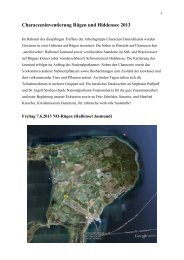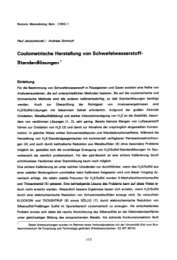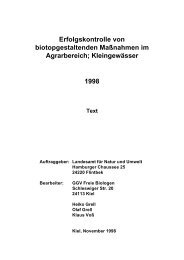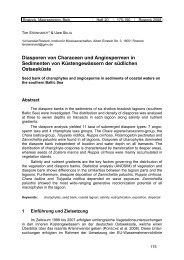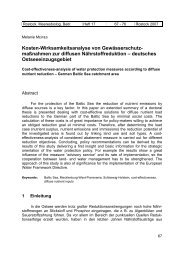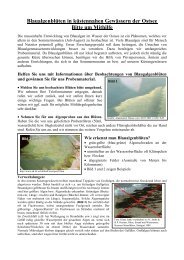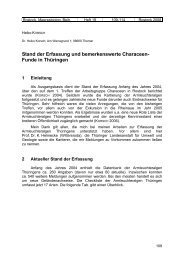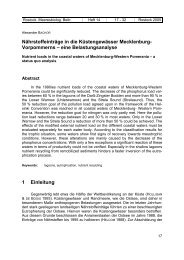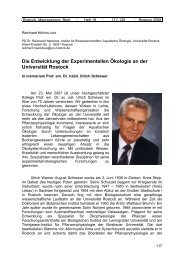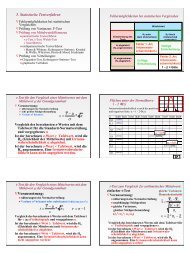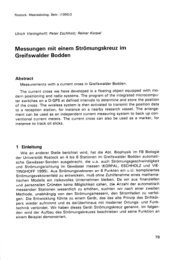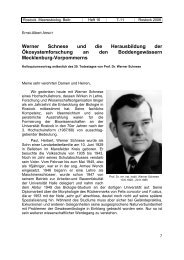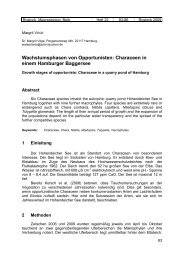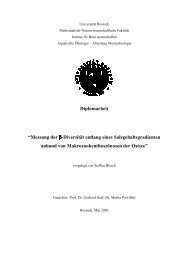Species and synonym list of the German marine - Institut für ...
Species and synonym list of the German marine - Institut für ...
Species and synonym list of the German marine - Institut für ...
You also want an ePaper? Increase the reach of your titles
YUMPU automatically turns print PDFs into web optimized ePapers that Google loves.
that exact ecophysiological knowledge <strong>of</strong> most rare or supposedly extinct species is<br />
missing <strong>and</strong> impede to draw specific conclusions.<br />
The Wadden Sea<br />
The knowledge about <strong>marine</strong> macroalgae <strong>of</strong> <strong>the</strong> <strong>German</strong> Wadden Sea <strong>and</strong> its<br />
presence on secondary hard substrates has never been in <strong>the</strong> focus <strong>of</strong> <strong>German</strong><br />
algologists, although several authors have focused on <strong>the</strong> species composition <strong>of</strong><br />
intertidal <strong>and</strong> subtidal benthic associations (NIENBURG 1927, LINKE 1939). <strong>Species</strong><br />
richness <strong>and</strong> <strong>the</strong> availability <strong>of</strong> substrates are similar between <strong>the</strong> Nor<strong>the</strong>rn <strong>and</strong><br />
Eastern Frisian Wadden Sea. Observed differences are most probably related to <strong>the</strong><br />
restricted research in <strong>the</strong> intertidal <strong>and</strong> subtidal mudflats <strong>and</strong> its existent hard<br />
substrata. Historical trends seem to be same between both areas <strong>and</strong> only differ in<br />
magnitude. This facilitates a joint historical overview: More than a hundred years ago,<br />
<strong>the</strong> first curator <strong>of</strong> botany at <strong>the</strong> Marine Station on Helgol<strong>and</strong> (Biologische Anstalt<br />
Helgol<strong>and</strong>) PAUL KUCKUCK (1866–1918), carried out some excursions to <strong>the</strong><br />
Wadden Sea <strong>and</strong> noted his records in a field diary. These records give us <strong>the</strong> first<br />
insights about <strong>the</strong> presence <strong>of</strong> macroalgae species on intertidal mudflats in <strong>the</strong><br />
former century. Twenty years before KUCKUCK, EIBEN (1871) had already studied<br />
<strong>the</strong> macroalgae associations on artificial structures like dikes <strong>and</strong> buoys.<br />
During <strong>the</strong> subsequent decades various authors studied macroalgae locally,<br />
for example in <strong>the</strong> vicinities <strong>of</strong> <strong>the</strong> Königshafen <strong>of</strong> <strong>the</strong> isl<strong>and</strong> Sylt (NIENBURG 1927,<br />
KORNMANN 1952, LUTHER 1976, SCHORIES et al 1997) or in <strong>the</strong> Weser estuary (LINKE<br />
1939, BEHRE 1961, MICHAELIS 1969, KOEMAN 1975). During <strong>the</strong> 1980s KOEMAN & VAN<br />
DEN HOEK (1982a, b, 1984) studied <strong>the</strong> taxonomy <strong>of</strong> <strong>the</strong> genus Enteromorpha in <strong>the</strong><br />
Ne<strong>the</strong>rl<strong>and</strong>s but samples were also taken from <strong>German</strong>y. At <strong>the</strong> end <strong>of</strong> <strong>the</strong> 1980s<br />
green algae mats covered wide areas <strong>of</strong> <strong>the</strong> East & North Frisian Wadden Sea<br />
(REISE & SIEBERT 1994, SCHANZ & REISE 2005, REISE et al. 2008). Single mats<br />
covered up to 9 km 2 in <strong>the</strong> East Frisian Wadden Sea. Early information about<br />
macroalgae in <strong>the</strong> subtidal channels <strong>and</strong> deeper waters were <strong>of</strong>ten provided due to<br />
<strong>the</strong> harvest <strong>of</strong> mussels <strong>and</strong> oysters (HAGMEIER & KÄNDLER 1927, HAGMEIER 1941),<br />
however natural banks had already declined significantly by <strong>the</strong> 1850s (MOEBUIS<br />
1877, GESSNER 1957). Riffs built by <strong>the</strong> polychaete Sabellaria spinulosa might have<br />
been important substrates for algae growth but today nearly all riffs have<br />
disappeared (EIBEN 1871, VORBERG 2005). Due to this phenomenon green algae<br />
distribution <strong>and</strong> identification has been studied in more detail (KOLBE et al. 1995,<br />
SCHORIES 1995). Never<strong>the</strong>less our knowledge about macroalgae distribution in <strong>the</strong><br />
Wadden Sea remains a patchwork. Additions to <strong>the</strong> actual check <strong>list</strong> are almost<br />
certain if future investigations concentrate on <strong>the</strong> low subtidal channels <strong>and</strong><br />
secondary hard substrata (VLAS et al. 2005).<br />
Baltic Sea<br />
First algae collections for <strong>the</strong> <strong>German</strong> coastal waters <strong>of</strong> <strong>the</strong> Baltic Sea go back<br />
to <strong>the</strong> year 1819 (LYNGBYE 1819). At <strong>the</strong> end <strong>of</strong> <strong>the</strong> 19th Century REINKE (1889)<br />
summarized <strong>the</strong> previous activities <strong>of</strong> material collected since 1819. He noted<br />
critically that many species had been incorrectly identified <strong>and</strong> were subsequently<br />
corrected by him. His work on <strong>the</strong> algal flora <strong>of</strong> <strong>the</strong> western Baltic Sea built toge<strong>the</strong>r<br />
12



